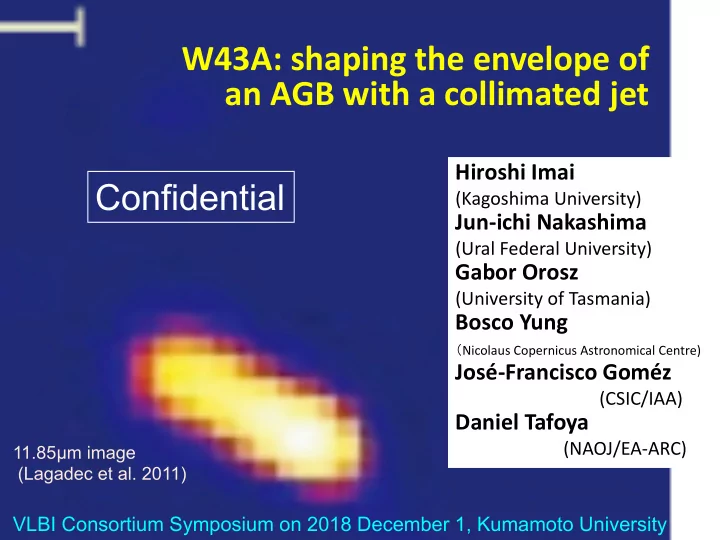

W43A: shaping the envelope of an AGB with a collimated jet Hiroshi Imai Confidential (Kagoshima University) Jun-ichi Nakashima (Ural Federal University) Gabor Orosz (University of Tasmania) Bosco Yung ( Nicolaus Copernicus Astronomical Centre) José-Francisco Goméz (CSIC/IAA) Daniel Tafoya (NAOJ/EA-ARC) 11.85μm image (Lagadec et al. 2011) VLBI Consortium Symposium on 2018 December 1, Kumamoto University
Transition phase Betelgeuse (Mira variable) from AGB to post-AGB star, ⓒ NASA from spherical symmetric to asymmetric circumstellar envelope W43A (OH/IR star, water fountain) Deguchi et al. 2007 ✦ When / how is a water fountain launched? Egg Nebula ✦ Which kind of star becomes a host of a water fountain? (post-AGB star) ⓒ NASA
Water fountain: highly-collimated stellar molecular jet traced by H 2 O maser emission 11.85μm image (Lagadec et al. 2011) H 2 O and OH masers in W43A (Imai et al. 2002) V exp (H 2 O) (>100 km/s) >> V exp (OH) (10 ー 30 km/s) • Very short dynamical time scale (?): <100 years • SPITZER/GLIMPSE Very high mass loss rate (?): d M /d t >10 -5 M sun yr -1 • image around W43A (Deguchi et al. 2007)
The origins of the jets: double stars or single star? W43A (Imai et al. 2008) • true and whole • H 2 O: jet morpho-kinematical • 1612 MHz OH: structures of stellar envelope jets in CO emission • SiO: torus • evolution of the structures • Central stellar system probably unresolved even with ALMA Cycle-6 • mass loss rates of beam (~20 mas) the jets • Central torus was marginally resolved with ALMA Cycle-4 beam (~40 mas)
What seen in 12 CO J =2 à 1 emission • Intermediate velocity components Confidential – Along the major axis of a MIR cavity – Consistent with low-velocity components of H 2 O masers 11.85μm image (Lagadec et al. 2011)
Evolution of the W43A jet
Previous precessing jet model Imai et al. 2002, 2005 • Precession period ~55 years • Precession angle amplitude ~5 ° • Gas bullets with ballistic motions from the central star and interactions with ambient envelope
Wrong precessing jet model by Imai et al. (2002) Chong et al. (2015)
A new model of H 2 O maser excitation region (Chong et al. 2015) • Bipolar cavity formed by past jet ejection • New interaction of newly ejected jet at the cavity wall • Periodic pattern of maser region produced by discontinuous ejection of 11.8 μm emission from a bipolar cavity of W43A jet or envelope (Lagadec et al. 2011)
Jet with a large opening angle Ballistic bow shock model • Formalization (Ostriker 2001) • Simulations (Lee et al. 2001) steady v.s pulsed jets • Application to water fountain jet to explain directions of maser motions and thickness of maser distribution (Orosz et al. 2017 in prep.) Steady jet Pulsed jet
Fast, decelerating, small-precessing jet model Tafoya et al. (in preparation) IRAS 16342-3814 Fastest components close to the central system
Anticorrelation between CO and dust continuum emission regions Confidential
Periodic outbursts of the jet Confidential Ejection period: P =5—7 years
Tracing the co-evolution of a collimated stellar jet and equatorial torus/flow • First outburst in W43A ~60 years ago • Interaction event between a compact stellar object and a torus followed by a jet on a short time scale • Binary system scenario may produce the interaction ⭐ event and explain (multiple) discrete mass ejection. W43A • The interaction event may occur in AGB phase. Statistical study is necessary. Mapping the whole envelope/ torus is crucial. Data point of W43A has been just determined.
Future perspectives FLASHING Finest Legacy Acquisitions of SiO and H 2 O masers Ignitions by Nobeyama Generation First observations on 2018 December 1 Simultaneous observations of SiO and H 2 O masers with new quasi-optics derived by HINOTORI (Hybrid Installation Project in Nobeyama, Triple-band Oriented) • Episodic outbursts • Periodicity • Evolution • devolution
Recommend
More recommend